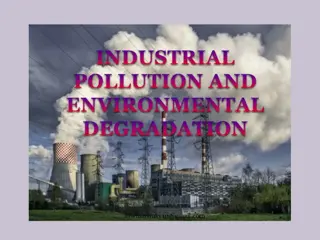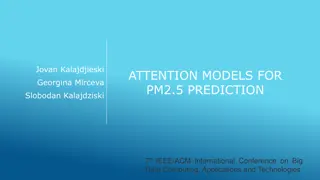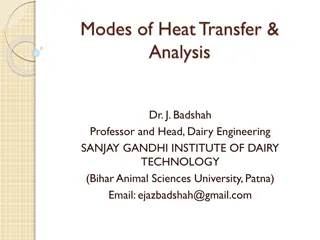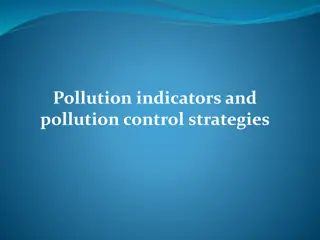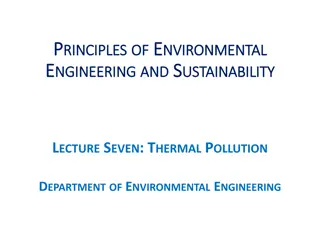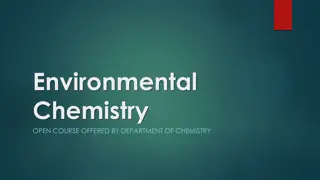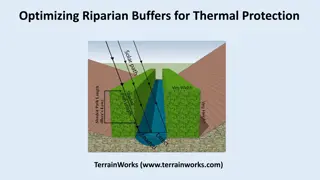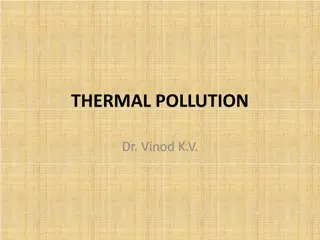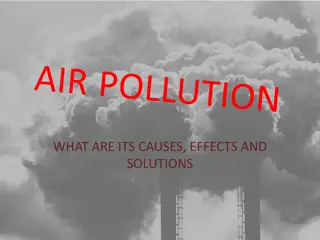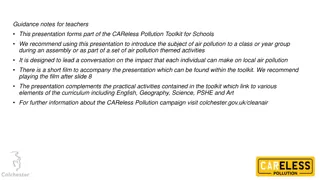Understanding Thermal Pollution Issues
Thermal pollution is a critical environmental concern caused by the increase in water temperature due to human activities like industrial effluents, power plants, and more. This degradation of water quality impacts aquatic ecosystems, leading to harmful effects on aquatic life. Understanding the causes and consequences of thermal pollution is essential to address and mitigate its detrimental effects on water bodies and biodiversity.
Download Presentation

Please find below an Image/Link to download the presentation.
The content on the website is provided AS IS for your information and personal use only. It may not be sold, licensed, or shared on other websites without obtaining consent from the author.If you encounter any issues during the download, it is possible that the publisher has removed the file from their server.
You are allowed to download the files provided on this website for personal or commercial use, subject to the condition that they are used lawfully. All files are the property of their respective owners.
The content on the website is provided AS IS for your information and personal use only. It may not be sold, licensed, or shared on other websites without obtaining consent from the author.
E N D
Presentation Transcript
www.studymafia.org Thermal Pollution Submitted To: www.studymafia.org Submitted By: www.studymafia.org
Introduction Thermal Pollution is the harmful increase in water temperature in streams, rivers, lakes, or occasionally, coastal ocean waters. It is the degradation of water quality by any process that changes ambient water temperature. A temperature increase as small as 1 or 2 Celsius degrees (about 2 to 4 Fahrenheit degrees) can kill native fish, shellfish, and plants, or drive them out in favor of other species, often with undesirable effects.
Explanation It occurs when an industry removes water from a source (e.g., a river), uses the water for cooling purposes, and then returns the heated water to its source. Power plants heat water to convert it into steam, to drive the turbines that generate electricity. For efficient functioning of the steam turbines, the steam is condensed into water after it leaves the turbines. This condensation is done by taking water from a water body to absorb the heat. This heated water, which is at least 15 degrees celsius higher than the normal, is later discharged back into the water body.
Causes The major sources of thermal pollution are discharge of heated water or hot waste material into water bodies from Nuclear power plant Industrial effluents Domestic sewage Hydro-electric power Coal fired power plants Thermal shock Other causes are : Deforestation Soil erosion
Nuclear power plants Nuclear power plants use water as a cooling agent. After the water is used, it is put back into a water supply at 9-20oC warmer . Emission from nuclear reactors increase the temperature of water bodies.
Coal-fired power plants Coal is utilized as a fuel. Condenser coils are cooled with water from nearby lake or river. The heated effluents decrease the DO of water. Damages the marine organisms.
Industrial Effluents Discharged power industry using turbo generators will have a higher temperature ranging from 6 to 9 C than the receiving water. water from steam-electric In modern stations, producing 100 MW, nearly one million gallons are discharged in an hour with increase in temperature of the cooling water passing by 8 to 10 C .
Domestic sewage Sewage is commonly discharged into lakes, canals or streams. Municipal sewage normally has a higher temperature than the receiving water. Increase in temperature of the receiving water decreases the dissolved oxygen of water. The foul smelling gases increased in water resulting in death of marine organisms.
Hydro electric power generation Generation of hydro electric power sometimes results in negative thermal loading in water systems. Creates less heat on water sources less than nuclear power plant.
Thermal Shock When a power plant first opens or shuts down for repair or other causes, fish and other organisms adapted to particular temperature range can be killed by the abrupt change in water temperature known as "thermal shock."
Deforestation Streams and small lakes are naturally kept cool by trees and other tall plants that block sunlight. People often remove this shading vegetation in order to harvest the wood in the trees, to make room for crops, or to construct buildings, roads, and other structures.
Soil Erosion Removal of vegetation far away from a stream or lake can contribute to thermal pollution by speeding up the erosion of soil into the water, making it muddy, which increases the light absorbed .
Effects Elevated temperature typically decreases the level of dissolved oxygen of water. Increases the metabolic rate of aquatic animals, as enzyme activity, resulting in these organisms consuming more food in a shorter time , which increases their need for oxygen. High temperature limits oxygen dispersion into deeper waters, contributing to anaerobic conditions.
This lead to increased bacteria levels when there is ample food supply. Many aquatic species will fail to reproduce at elevated temperatures. Primary producers are affected by warm water because higher water temperature increases plant growth rates, resulting in a shorter lifespan and species overpopulation.
Biotic effects Changes in the environment may also result in a migration of organisms to another, more suitable environment, and tin-migration of organisms that normally only live in warmer waters elsewhere. As a result one has the problem of compromising food chain of the old and new environments. Biodiversity can also be decreased as a result .
Changes of even one to two degrees celsius can cause significant changes in organism metabolism and other adverse cellular biology effects. Principal adverse changes can include rendering cell walls necessary osmosis, proteins, and alteration metabolism. These cellular level effects can adversely affect mortality and reproduction . less coagulation permeable to of enzyme cell of
Control Measures Energy chips Desalination plants Less nuclear power End shoreline deforestation Prevent soil erosion


